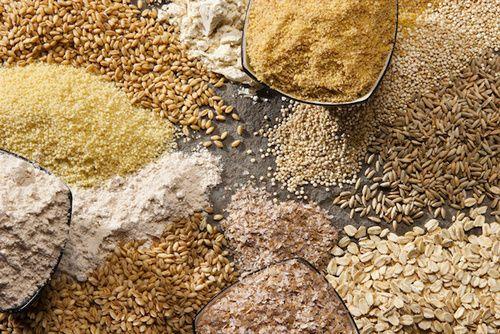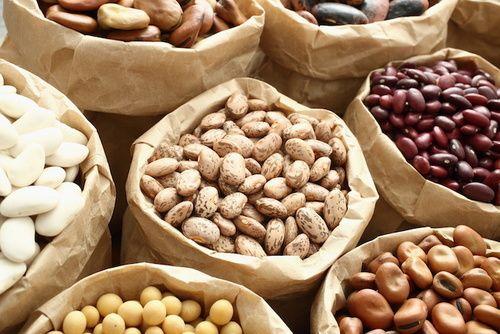I Whole grains are a good source of nutrients whose importance is value is greater compared to that of refined products. Let's find out better.
> Whole grains, what they are and what they are
> The structure of whole grains
> Properties and benefits
> Calories and nutritional values of whole grains

Whole grains, what they are and what they are
Cereals are plant seeds belonging to the grass family which wheat, rye, rice, oats and barley, which have been the basis of human nutrition for thousands of years. Today, the awareness that foods prepared with whole grains they can significantly contribute to improving our health and well-being and that the “complete” grain offers benefits from a nutritional point of view.
Traditional whole grains, such as barley and oats are gaining consumer confidence. Recognizing a wholemeal product might seem simple, but the fact that it has a darker color or declaring a high fiber content on the packaging is not in itself a guarantee.
check that a product is truly integral you need to read the label. In general, it is necessary to check that the package shows the wording "integral" ("Whole wheat flour", "100% whole wheat" etc.). In the list of ingredients, whole grains will appear separately by type (for example, whole wheat flour, whole oats, whole corn) and in many whole foods they will appear at the top. The dark color of a food does not guarantee that it is based on whole grains.
Many wholegrain products (such as breakfast cereals) are, indeed, light in color. Furthermore, i whole grain products are not always dry: on the contrary, they can be pleasantly compact and aromatic or still light and crunchy like breakfast flakes.
Il fiber content of a wholemeal food varies according to the type of cereal contained, the amount of bran present, the density of the product and the moisture content. Foods enriched with wheat or oat bran can be high in fiber while not whole.
The structure of whole grains
Each grain of cereal consists of three distinct sections:
- the external bran, rich in fiber,
- the internal germ, rich in micronutrients,
- the endosperm, rich in starches.
I Whole grains include all three components of the grain and can be eaten whole, crushed, split, flaked or ground.
Very often whole grains come reduced to flour and used to make bread, breakfast flakes, pasta, crackers and other products. Regardless of how the cereal is processed, the whole grain product must retain approximately the same proportion of bran, germ and endosperm as present in the original grain.
In order to be defined as "whole", foods they don't necessarily have to be made from 100% whole grains, but they must contain at least 51% (all three components: endosperm, germ and bran).
Whole grains, such as legumes, are among the high-fiber foods

Properties and benefits of whole grains
Whole grain grains, unprocessed, are a valuable asset source of fiber and micronutrients, such as antioxidants, vitamins, minerals. They are also a good source of polyunsaturated fatty acids. In fact, when the outer layers of these foods are removed and the grains are refined, what is left is just starch and protein.
The micronutrients contained in the whole grain instead perform important functions: they improve the immune defenses, reduce inflammatory processes, contribute to protect cells from free radicals and more.
The fiber taken by eating whole grains, preferably in grains, in addition to promoting good intestinal functioning, necessary to avoid states of intoxication of the organism, plays a fundamental role in prevention of cardiovascular diseasesie colon cancer.
Furthermore, the soluble part of the fiber is an excellent nourishment for the intestinal bacterial flora. Even starches, if eaten from the whole grain, have a relatively low glycemic and insulinemic index, reducing all the risks associated with high GI (Glycemic Index) foods.
Il refining process eliminates most of the fibers, fatty acids, vitamins of group B, and about 25% of proteins. Since most of the healthful components are found in bran and germ, foods prepared with whole grains can play an essential role in maintaining good health. In particular we have i following benefits:
- Heart ailments: Individuals who eat three or more servings of whole grain foods a day have a 20 or 30% lower chance of developing cardiovascular problems than those who eat less.
- Cholesterol: Some components of certain whole grains, including soluble fiber, beta-glucan, alpha-tocotrienol and arginine-lysine ratio, are thought to play a role in lowering blood cholesterol.
- Tumors: Whole grains appear to be associated with a lower risk of developing various cancers of the gastrointestinal tract.
- Gastrointestinal health: The components of whole grains, including fiber, resistant starches and oligosaccharides play a role in supporting gastrointestinal health, promoting intestinal regularity, helping to alleviate constipation and reducing the risk of diverticulosis and diverticulitis.
- Diabetes: Whole grains can improve blood sugar regulation in people with diabetes, reduce fasting plasma insulin and insulin resistance in non-diabetics. Certain components of whole grains, including magnesium, fiber, vitamin E, phytic acids, lecithins, and phenolic compounds, are believed to help reduce the risk of type 2 diabetes, as well as lower plasma glucose levels and insulin.
- Weight management: The intake of whole grains can contribute to achieving and maintaining an adequate weight. People who consume whole grains as part of a balanced diet are less likely to gain weight over time. Mechanisms by which whole grains can facilitate weight management include a higher and prolonged sense of satiety (regulation of calories consumed with the meal to reduce daily caloric intake) and prolonged gastric emptying times to delay the return of the feeling of hunger.
Whole grains, allies of
Whole grains are rich in nutrients that have a beneficial effect on heart and gut health.
Calories and nutritional values of whole grains
The benefits of whole grains are largely associated with consuming all of their nutrients, which they include Vitamins (group B and vitamin E), mineral salts (iron, magnesium and potassium, zinc, selenium), essential fatty acids, fitochimici (physiologically active substances of plants that bring functional health benefits) and other bioactive components.
Many of the beneficial substances are found in germ and bran and include resistant starches, oligosaccharides, inulin, lignans, phytosterols, phytic acid, tannins, lipids and antioxidants, such as phenolic acids and flavonoids. These nutrients when consumed together have a additive and synergistic effect on health.
There are several whole grains and the caloric intake varies according to the species. For example, 100 g of oats contain 389 kcal, 100 g of pearl barley contain 319 kcal / 1333 kj.
How to use them
Whole grains can be a food itself, such as oatmeal (porridge), brown rice, barley or corn (popcorn), or used as ingredients within a food, such as wholemeal flour in bread or breakfast cereals.
Whole grain products available on the market include wheat Wholemeal, Oats, Wholemeal Oatmeal, Whole Corn Flour, Corn (Popcorn), Brown Rice, rye wholemeal, wholemeal barley, wild rice, buckwheat, triticale, bulgur (crushed wheat), millet, the quinoa and sorghum.
Less common products include amaranth, spelled, pearl durum wheat and spelled.
benefit from the health effects of whole grains we recommend consume three servings a day. Incorporating whole grains into your diet is simple: just replace a few portions of refined foods with their whole grain version.
The introduction of whole grains should be gradual, in order to allow the body to adapt to the higher fiber content.
READ MORE
Whole grains among selenium-rich foods: discover the others
Other articles on whole grains:
> Cereals, a source of energy
> Whole grains among anti cancer foods
> Lazy bowel? Space for whole grains
> Whole grains among the foods against headache
> What pseudocereals are and how to use them
> The recipes for whole grain biscuits
> Cereal soup: 3 tasty recipes
| post.co.uk


























